Simon Schwartzman and Elizabeth Balbachevsky
Universidade de São Paulo| Table 2: Doctoral degrees and full-time contracts by field (survey data) | |||||
| % with doctoral degrees or full professorships | % with full-time contracts | % of "errors* | Total (N) | ||
| % | N | ||||
| Physical sciences | 48.0 | 83.7 | 41.7 | 12.9 | 123 |
| Biological Sciences | 31.7 | 73.3 | 55.1 | 11.0 | 105 |
| Social Sciences | 27.1 | 52.9 | 39.7 | 7.3 | 70 |
| Humanities | 28.7 | 59.1 | 41.2 | 14.3 | 137 |
| Engineering | 15.5 | 33.6 | 39.7 | 14.0 | 134 |
| Health professions | 38.7 | 46,8 | 53.4 | 19.5 | 186 |
| social professions | 29.9 | 38.6 | 44.0 | 9.2 | 88 |
| technical professions | 16.7 | 40.6 | 44.4 | 3.2 | 34 |
| education | 16.0 | 55.0 | 50.6 | 8.4 | 80 |
| Total | 30.2 | 54.2 | 46.0 | 100% | 964 |
| *Percentage of doctors with full time employment plus non-doctors with part-time employment on the total | |||||
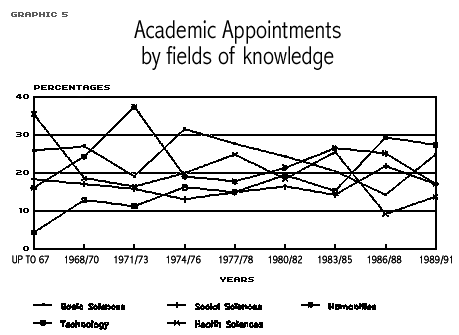
| Table 3: Doctoral degrees and full-time contracts by type of institution | |||||
| % with doctoral degrees and full professorships | % with full-time contracts | % of "errors"* | Total (N) | ||
| % | N | ||||
| State (São Paulo) | 68.5 | 74.8 | 16.4 | 15.5 | 149 |
| State (others) | 8.4 | 70.6 | 69.2 | 11.1 | 107 |
| Federal | 30.3 | 72.5 | 67.5 | 41.8 | 403 |
| Private | 18.0 | 15.1 | 23.9 | 31.6 | 305 |
| Total | 30.2 | 54.2 | 46.0 | 100% | 964 |
| *Percentage of doctors with full time employment plus non-doctors with part-time employment on the total | |||||
| Table 4. Percentage of professors with full-time and stable contracts, by institution and academic degrees. | |||||
| State (SP) | Sate (others) | Federal | Private | Total | |
| Undergraduate | 30,8% | 60,9% | 95,2% | 16,0% | 47,2% |
| Specialization | 40,0% | 77,5% | 97,1% | 24,3% | 63,4% |
| Masters Degree | 32,0% | 82,4% | 95,8% | 26,9% | 70,4% |
| Doctor's degree | 64,3% | 62,5% | 93,6% | 29,4% | 71,8% |
| Associate or full professor | 85,5% | 100% | 96,3% | 50,0% | 82,9% |
| Total | 59,1% | 74,5% | 95,5% | 24,0% | 65,5% |
| (N) | (149) | (106) | (396) | (287) | (938) |
| Table 5: Percentage of earnings deriving from professional work (averages): | |||
| From this institution | from other academic sources | from non-academic work | |
| A) Type of Institution: | |||
| State (São Paulo) | 77.4 | 5.8 | 15.9 |
| State (others) | 77.0 | 6.2 | 16.0 |
| Federal | 14.5 | 5.5 | 19.3 |
| Private | 37.9 | 16.1 | 42.4 |
| B) Fields of knowledge | |||
| Basic and Natural Sciences | 80.3 | 8.3 | 10.7 |
| Social sciences and professions | 50.3 | 9.3 | 34.1 |
| Humanities and literature | 72.4 | 10.9 | 15.3 |
| Technology | 50.2 | 11.6 | 37.6 |
| Health sciences and professions | 52.1 | 5.7 | 38.4 |
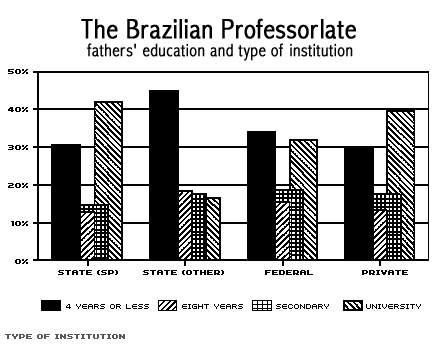
| Table 6: Age, year when started academic work, age when started, income and academic degree, by sex | ||
| Women | Men | |
| Year of birth | 1947.39 | 1950.72 |
| year started academic work | 1979,58 | 1977,56 |
| age when started | 28,87 | 30,07 |
| % with less than US$10,000 a year | 67,9% | 47,0% |
| % with more than US$ 25,000 a year | 6.0% | 16,0% |
| % with full-time contracts | 66,6% | 36,5% |
| % with masters' degrees (no Ph.D) | 38.9% | 23.2% |
| % with doctor's degrees | 20.0% | 22,6% |
| % of "errors" | 53.1% | 41.5% |
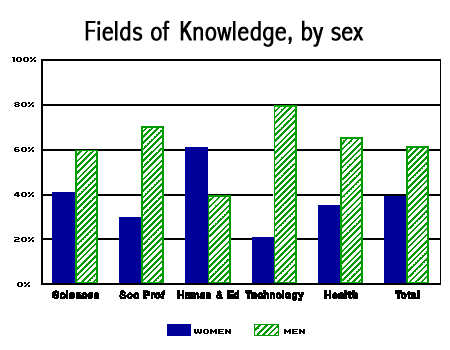
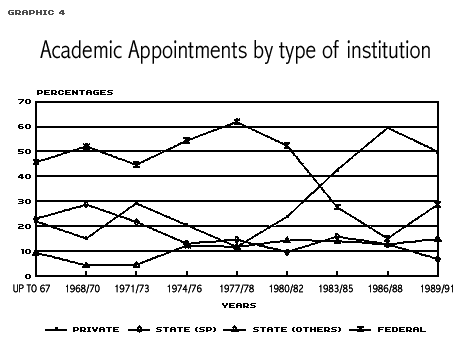
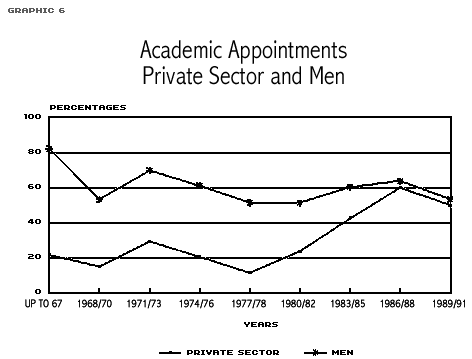

| Table 7: Yearly income from academic work (percentages in each class) | ||||
| Up to US$5,000.00 | between 5 and 10,000 | between 10 and 25,000 | more than 15,000 | |
| By institutional setting | ||||
| State (SP) | 10,1 | 20,1 | 51,0 | 12,1 |
| State (other) | 47,1 | 42,3 | 7,7 | 2,9 |
| Federal | 234 | 32,7 | 35,3 | 8.6 |
| Private | 31,8 | 22,4 | 29,2 | 16,6 |
| By academic degree: | ||||
| undergraduate | 44,2 | 24,9 | 18,8 | 12,2 |
| specialization | 41,2 | 32,0 | 21,5 | 5,0 |
| Master's degree | 24,0 | 40,7 | 28,4 | 6,9 |
| Doctor's degree | 6,8 | 18,4 | 56,8 | 18,0 |
| Full or associate professor | 7,9 | 15,8 | 46,1 | 30,3 |
| Total | 26,6 | 28,5 | 32,8 | 12.2 |
| Table 8: evaluation of income earned, job attitudes and social standing of the profession, by institution (mean values) | ||||
| State (SP) | State (others) | Federal | Private | |
| How would you rate your own academic salary? (1: excellent; 4: poor) | 3.2 | 3.4 | 3.3 | 3.1 |
| How would you rate the prospects of improvement in the coming five years (1-4) | 3.5 | 3.8 | 3.6 | 3.2 |
| How do you evaluate your retirement benefits? (1-5) | 2.3 | 3.8 | 2.6 | 4.2 |
| Academics are among the most influential opinion leaders (1: agree; 5: disagree) | 3.2 | 3.2 | 3.1 | 3.2 |
| respect of academics is declining (1-5) | 2.0 | 1.4 | 1.7 | 2.0 |
| If you left this institution, how easy it would be for you to find another professional, non academic alternative (1: very easy; 5: very difficult) | 2.2 | 2.7 | 2.4 | 2.2 |
| If you left this institution, how easy it would be for you to find another professional, academic alternative (1-5) | 1.9 | 2.8 | 2.4 | 2.5 |
| How likely is it that you will leave this institution in the next five years? (1: very likely; 5:very unlikely). | 4.1 | 3.3 | 3.9 | 3.4 |